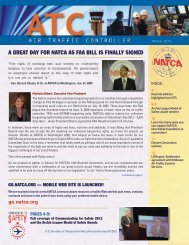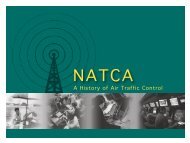Against the Wind - National Air Traffic Controllers Association
Against the Wind - National Air Traffic Controllers Association
Against the Wind - National Air Traffic Controllers Association
Create successful ePaper yourself
Turn your PDF publications into a flip-book with our unique Google optimized e-Paper software.
A Logo is Born<br />
Like many of NATCA’s founders, <strong>the</strong><br />
union’s logo traced its heritage to<br />
AATCC. In <strong>the</strong> fall of 1984, Howie Barte<br />
took a break from<br />
drumming up support<br />
on <strong>the</strong> phone<br />
one day to sketch<br />
out a logo for New England’s<br />
monthly newslet- ters.<br />
The circular<br />
artwork paid hom- age<br />
to centers and<br />
TRACONs with its<br />
dotted and crosshatched<br />
lines and<br />
o<strong>the</strong>r markings representing<br />
a radarscope, and was anchored<br />
by a control tower near <strong>the</strong> bottom.<br />
Influenced by his interest in “Star Trek,”<br />
he selected a computer-style typeface for<br />
<strong>the</strong> initials AATCC in <strong>the</strong> center.<br />
After <strong>the</strong> logo’s debut in <strong>the</strong> October<br />
edition of <strong>the</strong> New England AATCC<br />
Update, Barte collaborated with Kim<br />
Kochis, ano<strong>the</strong>r controller on his crew at<br />
Quonset TRACON. *<br />
Kochis, who loved to draw and<br />
<br />
paint, relied on graphic design skills she<br />
developed in high school. By <strong>the</strong> time<br />
Barte and Kochis were finished, concentric<br />
circles with a radar sweep<br />
had replaced <strong>the</strong> radar<br />
map. A tower cab rested<br />
atop <strong>the</strong> “T” in a series of<br />
simple block letters spelling<br />
AATCC.<br />
Barte presented<br />
<strong>the</strong> finished product for<br />
formal adoption at an<br />
AATCC regional representatives<br />
meeting in<br />
March 1985. But a few<br />
controllers argued that<br />
it didn’t adequately represent en route<br />
centers.<br />
Unwilling to change <strong>the</strong> design,<br />
Barte used it throughout <strong>the</strong> year in<br />
New England. When MEBA entered <strong>the</strong><br />
picture, he gave a copy to Thornton, who<br />
turned it over to <strong>the</strong> union’s graphic artist.<br />
The resulting logo, with red letters<br />
and blue lines, made Barte swell with<br />
pride when he saw it at NATCA’s first<br />
national meeting.<br />
Chapter 3: A Long and <strong>Wind</strong>ing Road<br />
The logo was subsequently trademarked<br />
in 1993, and in 2000 <strong>the</strong>n-President<br />
Michael McNally presented Barte<br />
with a plaque recognizing<br />
him for his efforts<br />
in creating <strong>the</strong><br />
union’s longstanding<br />
symbol.<br />
Noting that<br />
many companies<br />
change <strong>the</strong>ir visual<br />
identity as <strong>the</strong>y<br />
mature, Kochis says,<br />
“I’m surprised it’s<br />
held all <strong>the</strong>se years.”<br />
Two unsuccessful<br />
attempts to redesign <strong>the</strong> logo<br />
were made during <strong>the</strong> 1990s. To help<br />
ensure its enduring look, NATCA convention<br />
delegates in 2000 mandated<br />
that any changes must be approved by a<br />
majority vote at a convention.<br />
* Kochis later transferred to two o<strong>the</strong>r New England facilities<br />
before settling in at Raleigh-Durham Tower/TRACON in<br />
North Carolina in May 1995.<br />
71




